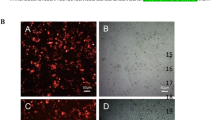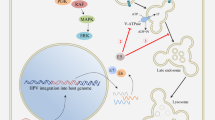Abstract
In this study, we investigated the suppressive effect of a short hairpin RNA delivered by a lentiviral vector (LV-shRNA) against human papillomavirus (HPV) type 18 E6 on the expression of the oncogenes E6 and E7 in cervical cancer HeLa cells both in vitro and in vivo. The LV-shRNA effectively delivered the shRNA to HeLa cells and lead to a dose-dependent reduction of E7 protein and the stabilization of E6 target proteins, p53 and p21. Low-dose infection of HeLa cells with LV-shRNA caused reduced cell growth and the induction of senescence, whereas a high-dose infection resulted in specific cell death via apoptosis. Transplant of HeLa cells infected with a low dose of LV-shRNA into Rag−/− mice significantly reduced the tumor weight, whereas transplant of cells infected with a high dose resulted in a complete loss of tumor growth. Systemic delivery of LV-shRNA into mice with established HeLa cell lung metastases led to a significant reduction in the number of tumor nodules. Our data collectively suggest that lentiviral delivery is an effective way to achieve stable suppression of E6/E7 oncogene expression and induce inhibition of tumor growth both in vitro and in vivo. These results encourage further investigation of this form of RNA interference as a promising treatment for cervical cancer.
This is a preview of subscription content, access via your institution
Access options
Subscribe to this journal
Receive 12 print issues and online access
$259.00 per year
only $21.58 per issue
Buy this article
- Purchase on Springer Link
- Instant access to full article PDF
Prices may be subject to local taxes which are calculated during checkout







Similar content being viewed by others
References
zur Hausen H . Papillomaviruses and cancer: from basic studies to clinical application. Nat Rev Cancer 2002; 2: 342–350.
DiPaolo JA, Alvarez-Salas LM . Advances in the development of therapeutic nucleic acids against cervical cancer. Expert Opin Biol Ther 2004; 4: 1251–1264.
Parkin DM, Bray FI, Devesa SS . Cancer burden in the year 2000. The global picture. Eur J Cancer 2001; 37: S4–S66.
Parkin DM, Bray F, Ferlay J, Pisani P . Global cancer statistics, 2002. CA Cancer J Clin 2005; 55: 74–108.
Goodwin EC, DiMaio D . Repression of human papillomavirus oncogenes in HeLa cervical carcinoma cells causes the orderly reactivation of dormant tumor suppressor pathways. Proc Natl Acad Sci USA 2000; 97: 12513–12518.
Munger K, Werness BA, Dyson N, Phelps WC, Harlow E, Howley PM . Complex formation of human papillomavirus E7 proteins with the retinoblastoma tumor suppressor gene product. EMBO J 1989; 8: 4099–4105.
von Knebel Doeberitz M, Oltersdorf T, Schwarz E, Gissmann L . Correlation of modified human papilloma virus early gene expression with altered growth properties in C4-1 cervical carcinoma cells. Cancer Res 1988; 48: 3780–3786.
Bitko V, Musiyenko A, Shulyayeva O, Barik S . Inhibition of respiratory viruses by nasally administered siRNA. Nat Med 2005; 11: 50–55.
Capodici J, Kariko K, Weissman D . Inhibition of HIV-1 infection by small interfering RNA-mediated RNA interference. J Immunol 2002; 169: 5196–5201.
Dasgupta R, Perrimon N . Using RNAi to catch Drosophila genes in a web of interactions: insights into cancer research. Oncogene 2004; 23: 8359–8365.
Hannon GJ, Rossi JJ . Unlocking the potential of the human genome with RNA interference. Nature 2004; 431: 371–378.
Jacque JM, Triques K, Stevenson M . Modulation of HIV-1 replication by RNA interference. Nature 2002; 418: 435–438.
Butz K, Ristriani T, Hengstermann A, Denk C, Scheffner M, Hoppe-Seyler F . siRNA targeting of the viral E6 oncogene efficiently kills human papillomavirus-positive cancer cells. Oncogene 2003; 22: 5938–5945.
Hall AH, Alexander KA . RNA interference of human papillomavirus type 18 E6 and E7 induces senescence in HeLa cells. J Virol 2003; 77: 6066–6069.
Jiang M, Milner J . Selective silencing of viral gene expression in HPV-positive human cervical carcinoma cells treated with siRNA, a primer of RNA interference. Oncogene 2002; 21: 6041–6048.
Jiang M, Rubbi CP, Milner J . Gel-based application of siRNA to human epithelial cancer cells induces RNAi-dependent apoptosis. Oligonucleotides 2004; 14: 239–248.
Yoshinouchi M, Yamada T, Kizaki M, Fen J, Koseki T, Ikeda Y et al. In vitro and in vivo growth suppression of human papillomavirus 16-positive cervical cancer cells by E6 siRNA. Mol Ther 2003; 8: 762–768.
Yamato K, Fen J, Kobuchi H, Nasu Y, Yamada T, Nishihara T et al. Induction of cell death in human papillomavirus 18-positive cervical cancer cells by E6 siRNA. Cancer Gene Ther 2006; 13: 234–241.
Kafri T, van Praag H, Gage FH, Verma IM . Lentiviral vectors: regulated gene expression. Mol Ther 2000; 1: 516–521.
Miyoshi H, Blomer U, Takahashi M, Gage FH, Verma IM . Development of a self-inactivating lentivirus vector. J Virol 1998; 72: 8150–8157.
Naldini L, Verma IM . Lentiviral vectors. Adv Virus Res 2000; 55: 599–609.
Check E . Pioneering HIV treatment would use interference and gene therapy. Nature 2005; 437: 601.
Humeau LM, Binder GK, Lu X, Slepushkin V, Merling R, Echeagaray P et al. Efficient lentiviral vector-mediated control of HIV-1 replication in CD4 lymphocytes from diverse HIV+ infected patients grouped according to CD4 count and viral load. Mol Ther 2004; 9: 902–913.
Scherr M, Eder M . Gene transfer into hematopoietic stem cells using lentiviral vectors. Curr Gene Ther 2002; 2: 45–55.
Scheffner M, Whitaker NJ . Human papillomavirus-induced carcinogenesis and the ubiquitin–proteasome system. Semin Cancer Biol 2003; 13: 59–67.
Horner SM, DeFilippis RA, Manuelidis L, DiMaio D . Repression of the human papillomavirus E6 gene initiates p53-dependent, telomerase-independent senescence and apoptosis in HeLa cervical carcinoma cells. J Virol 2004; 78: 4063–4073.
Butz K, Denk C, Ullmann A, Scheffner M, Hoppe-Seyler F . Induction of apoptosis in human papillomaviruspositive cancer cells by peptide aptamers targeting the viral E6 oncoprotein. Proc Natl Acad Sci USA 2000; 97: 6693–6697.
Cho CW, Poo H, Cho YS, Cho MC, Lee KA, Lee SJ et al. HPV E6 antisense induces apoptosis in CaSki cells via suppression of E6 splicing. Exp Mol Med 2002; 34: 159–166.
Putral L, Bywater M, Gu W, Saunders N, Gabrielli B, Leggatt G et al. RNAi against HPV oncogenes in cervical cancer cells results in increased sensitivity to cisplatin. Mol Pharmacol 2005; 68: 1311–1319.
Dull T, Zufferey R, Kelly M, Mandel R J, Nguyen M, Trono D et al. A third-generation lentivirus vector with a conditional packaging system. J Virol. 1998; 72: 8463–8471.
Chomczynski P, Sacchi N . Single-step method of RNA isolation by acid guanidinium thiocyanate–phenol–chloroform extraction. Anal Biochem 1987; 162: 156–159.
Klein D, Bugl B, Gunzburg WH, Salmons B . Accurate estimation of transduction efficiency necessitates a multiplex real-time PCR. Gene Therapy 2000; 7: 458–463.
Gu W, Janssens P, Holland M, Seamark R, Kerr P . Lymphocytes and MHC class II positive cells in the female rabbit reproductive tract before and after ovulation. Immunol Cell Biol 2005; 83: 596–606.
Dimri GP, Lee X, Basile G, Acosta M, Scott G, Roskelley C et al. A biomarker that identifies senescent human cells in culture and in aging skin in vivo. Proc Natl Acad Sci USA 1995; 92: 9363–9367.
DeFilippis RA, Goodwin EC, Wu L, DiMaio D . Endogenous human papillomavirus E6 and E7 proteins differentially regulate proliferation, senescence, and apoptosis in HeLa cervical carcinoma cells. J Virol 2003; 77: 1551–1563.
Cory S, Adams JM . The Bcl2 family: regulators of the cellular life-or-death switch. Nat Rev Cancer 2002; 2: 647–656.
Johnson TM, Yu ZX, Ferrans VJ, Lowenstein RA, Finkel T . Reactive oxygen species are downstream mediators of p53-dependent apoptosis. Proc Natl Acad Sci USA 1996; 93: 11848–11852.
Polyak K, Xia Y, Zweier JL, Kinzler KW, Vogelstein B . A model for p53-induced apoptosis. Nature 1997; 389: 300–305.
Haupt S, Berger M, Goldberg Z, Haupt Y . Apoptosis – the p53 network. J Cell Sci 2003; 116: 4077–4085.
Edinger AL, Thompson CB . Death by design: apoptosis, necrosis and autophagy. Curr Opin Cell Biol 2004; 16: 663–669.
Talloczy Z, Jiang W, Virgin HW, Leib DA, Scheuner D, Kaufman RJ et al. Regulation of starvation- and virus-induced autophagy by the eIF2alpha kinase signaling pathway. Proc Natl Acad Sci USA 2002; 99: 190–195.
Copreni E, Penzo M, Carrabino S, Conese M . Lentivirus-mediated gene transfer to the respiratory epithelium: a promising approach to gene therapy of cystic fibrosis. Gene Therapy 2004; 11(Suppl 1): S67–S75.
Acknowledgements
We thank Dr Brian Gabrielli for helpful suggestions for the study, and Drs Heather Beamish, Leonore de Boer and Ibtissam Abdul Jabbar for their technical help. This work was supported by grants from the National Health and Medical Research Council, the University of Queensland and the Princess Alexandra Hospital Research Foundation.
Author information
Authors and Affiliations
Corresponding author
Rights and permissions
About this article
Cite this article
Gu, W., Putral, L., Hengst, K. et al. Inhibition of cervical cancer cell growth in vitro and in vivo with lentiviral-vector delivered short hairpin RNA targeting human papillomavirus E6 and E7 oncogenes. Cancer Gene Ther 13, 1023–1032 (2006). https://doi.org/10.1038/sj.cgt.7700971
Received:
Revised:
Accepted:
Published:
Issue Date:
DOI: https://doi.org/10.1038/sj.cgt.7700971
Keywords
This article is cited by
-
Gamma tocotrienol targets tyrosine phosphatase SHP2 in mammospheres resulting in cell death through RAS/ERK pathway
BMC Cancer (2015)
-
In vivo comparison of local versus systemic delivery of immunostimulating siRNA in HPV‐driven tumours
Immunology & Cell Biology (2014)
-
Cell growth inhibition in HPV 18 positive uveal melanoma cells by E6/E7 siRNA
Tumor Biology (2013)
-
Progress Toward In Vivo Use of siRNAs-II
Molecular Therapy (2012)
-
RNA Interference with Special Reference to Combating Viruses of Crustacea
Indian Journal of Virology (2012)



